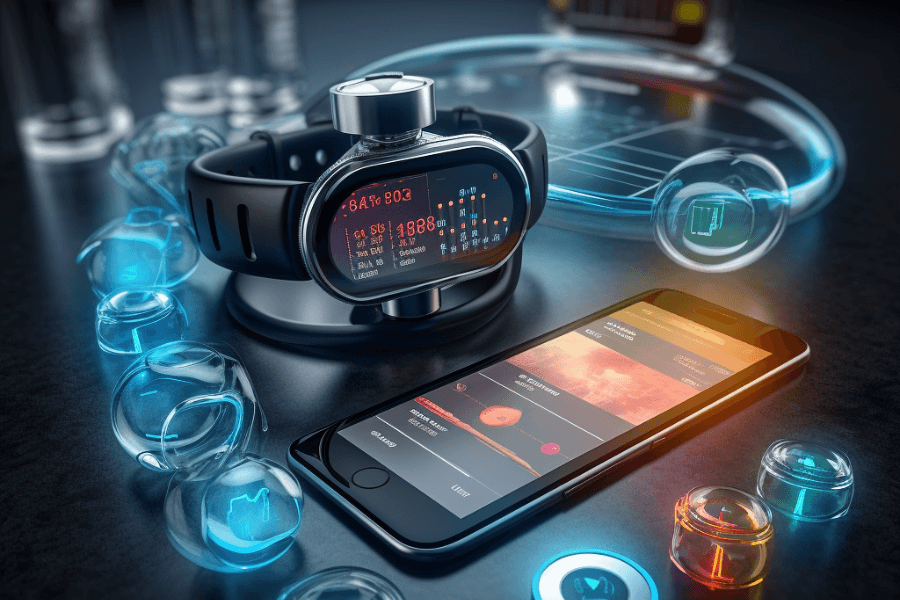The future of mobile health in recent years has seen advancements in technology which has revolutionised the healthcare industry. One such technology is photoplethysmography (PPG), which has been used in medical devices like oximeters as well as wearables, enabling the measurement of blood pressure, oxygen saturation, and cardiac output.. PPG technology has the potential to transform healthcare by enabling remote vital signs monitoring, making health and wellness more accessible and affordable for more people and enabling a shift from reactive to preventive care.
Remote Vital Signs Monitoring
Remote vital signs monitoring using PPG technology has the potential to revolutionise healthcare by enabling people to measure their health and wellness daily, so that they can become aware of health issues before they worsen. This also enables them to make the right changes, track their progress and turn wellness into a proactive way of life rather than a reactive measure. This technology is particularly useful for insurance, telemedicine and workplace health, where it can help prioritise employee health and wellbeing, leading to increased productivity and job satisfaction.
Accessibility and Affordability
PPG technology is making health and wellness more accessible and affordable for more people. While routine and quality care has often been limited to those who could afford to frequently take time off to travel to clinics or purchase an array of costly devices, today PPG and rPPG, are enabling people to take such measurements from local kiosks, computers in public centers, or from mobile devices they already possess like smartphones. This technology is particularly useful for mass screening, as PPG signals collected from mobile phone applications can be very beneficial to build standard health indices and measurements nationwide. Imagine if we had this technology rolled out during COVID-19 and we had the ability to measure who had low SPo2 or potential COVID-19 signs at scale, rPPG technology can be used for such scenarios where its been tested and validated.
PPG for Preventive Care
PPG technology is enabling a shift from reactive to preventive care. Today, PPG and rPPG enable people to measure their health and wellness daily, so that they can become aware of health issues before they worsen. This also enables them to make the right changes, track their progress, and turn wellness into a proactive way of life rather than a reactive measure. This technology is particularly useful for outpatient care, pediatrics, surgery, remote monitoring during COVID-19, neurology, dialysis, and more.
PPG’s Role in Healthcare Advancements
PPG technology has the potential to transform healthcare by enabling remote vital signs monitoring, making health and wellness more accessible and affordable for more people, and enabling a shift from reactive to preventive care. PPG technology is particularly useful for insurance, telemedicine, and workplace health, where it can help prioritise employee health and wellbeing, leading to increased productivity and job satisfaction. As technology advances and new algorithms are developed, PPG technology will continue to improve, and its applications in healthcare will continue to expand.
PPG technology is already being used in medical devices and wearables, and its potential applications in healthcare are vast. PPG technology can be used for diagnosis, monitoring, screening, and fitness, and has the potential to transform healthcare by enabling remote vital signs monitoring, making health and wellness more accessible and affordable for more people, and enabling a shift from reactive to preventive care. As PPG technology continues to improve, its applications in healthcare will continue to expand, and it will play an increasingly important role in healthcare advancements.
What is PPG and how does it work?
PPG technology stands for photoplethysmography, which is a high precision light sensor used to detect the volume of blood flow to understand the fluctuation in heart rate. PPG technology is used to measure blood volume changes in the microvascular bed of tissue optically. The PPG signal itself comprises pulsatile (AC) and superimposed (DC) components. The AC component is provided by the variations in blood volume that arise from heartbeats, while the DC component is shaped by several factors, including respiration, sympathetic nervous system activity, and temperature regulation. PPG sensors use an infrared light emitting diode (IR-LED) or a green LED as the main light source. IR-LEDs are more sensitive for measuring the flow of blood that is more deeply concentrated in certain parts of the body such as the muscles, while green light is typically used for calculating the absorption of oxygen in oxyhemoglobin (oxygenated blood) and deoxyhemoglobin (blood without oxygen present). PPG technology can be utilized in many different devices, such as clips or cuffs, in many places on the body, such as fingers, wrists, forearms, and torsos. In healthcare settings, PPG technology is employed in the form of a pulse oximeter, a device sitting over a patient’s finger to measure oxygen saturation. When the heart beats, capillaries expand and contract based on blood volume changes. PPG optical sensor, utilizing motion-tolerant technology, emits light signals that reflect onto the skin to accurately and continuously measure weak blood flow signals.
Limitations of traditional PPG technology
Some limitations of traditional PPG technology include:
- Motion artifacts: PPG signals are susceptible to motion artifacts caused by hand movement, which can limit the accuracy of the data.
- Vulnerability to artifacts: The PPG signal is well-known to be very vulnerable to artifacts, and a good quality signal cannot be expected for most of the time in daily life.
- Limited coverage: PPG technology can be utilised in many different devices like smart watches, wearables, such as clips or cuffs, in many places on the body, such as fingers, wrists, forearms, and torsos. However, the measurement site is determined by the desired application, and coverage can be limited.
- Limited applications: While PPG technology has been used in medical devices like oximeters as well as wearables, enabling the measurement of blood pressure, oxygen saturation, and cardiac output, its applications are limited to certain areas of healthcare.
- Susceptibility to noise: PPG signals are susceptible to noise, which can create limitations in the application of PPG.
Therefore traditional PPG technology has some limitations, including motion artifacts, vulnerability to artifacts, limited coverage, limited applications, and susceptibility to noise. However, as technology advances and new algorithms are developed, these limitations can be overcome, and PPG technology will continue to play an important role in healthcare advancements.
What is rPPG and its use in the future of mobile health monitoring?
rPPG stands for remote photoplethysmography, which is a non-contact technique for measuring heart rate and other psychophysiological data using a video camera. It is a low-cost and convenient method for biomedical and clinical research, as it allows remote heart rate measurements with a simple camera or a smartphone and can also be integrated with augmented reality platforms. rPPG technology relies on a camera and measures red, green, and blue light reflection changes from the skin as the contrast between specular and diffusion reflections. Images or videos of human skin under ambient light sources or with dedicated illumination are recorded and processed to recover the plethysmography signal from which physiological parameters are extracted. rPPG technology is used in various domains, including healthcare, wellness, corporate wellness, telehealth, remote monitoring, home hospitals, and more.
rPPG technology has several benefits over traditional PPG technology, including:
- Non-invasiveness: rPPG technology is a non-invasive method of measuring blood flow and oxygen levels in the skin, which means that it does not require any sensors to be attached to the body. This makes it more comfortable and convenient for patients, especially those who require continuous monitoring.
- Accessibility: rPPG technology can be used in a variety of settings, including remote and rural areas where medical facilities are not readily available. It only requires a high-resolution camera, making it more accessible and affordable for more people. Typically rPPG solutions are used on mobile phones using the camera.
- Convenience: rPPG technology can be integrated with users mobile phones, making it more convenient for patients to monitor their health and wellness. It can also be used for mass screening, as PPG signals collected from phone applications can be very beneficial to build standard health indices and measurements nationwide.
- Accuracy: rPPG technology has been shown to be as accurate as traditional PPG technology in measuring heart rate and other vital signs. However, it is important to note that rPPG technology is sensitive to motion of the head, and it is recommended to use a setting where participants are sitting and not moving too much.
- Preventive Care: rPPG technology enables people to measure their health and wellness daily, so that they can become aware of health issues before they worsen. This also enables them to make the right changes, track their progress, and turn wellness into a proactive way of life rather than a reactive measure.
Limitations of rPPG technology
Some limitations of traditional rPPG technology include:

- Signal quality: rPPG signal quality ranges from highly accurate to extremely poor, resulting in an unstable, non-reproducible, and challenging-to-implement signal. A low-quality rPPG signal may lead to an underestimation of vital signs.
- Vulnerability to artifacts: The rPPG signal is well-known to be very vulnerable to artifacts, and a good quality signal cannot be expected for most of the time in daily life.
- Limited coverage: rPPG technology is typically used in a remote or non-contact setting, where the camera is not in direct contact with the skin. The measurement site is determined by the desired application, and coverage can be limited.
- Sensitivity to motion: rPPG measurement is sensitive to motion of the head, and it is recommended to use a setting where participants are sitting and not moving too much.
- Ambient light conditions: rPPG-based devices are often used in situations where the user may be moving or experiencing changes in ambient light conditions, such as during physical activity or outdoor use. In these situations, a high-quality rPPG signal is essential to ensure that the device can accurately and continuously track the user’s vital signs.
In conclusion, rPPG technology has several benefits over traditional PPG technology, including non-invasiveness, accessibility, convenience, accuracy, and preventive care. As technology advances and new algorithms are developed, rPPG technology will continue to improve, and its applications in healthcare will continue to expand with Vastmindz leading the way.
To learn more about how Vastmindz develops solutions using rPPG for insurance, telemedicine and wellness contact us for a demo.


